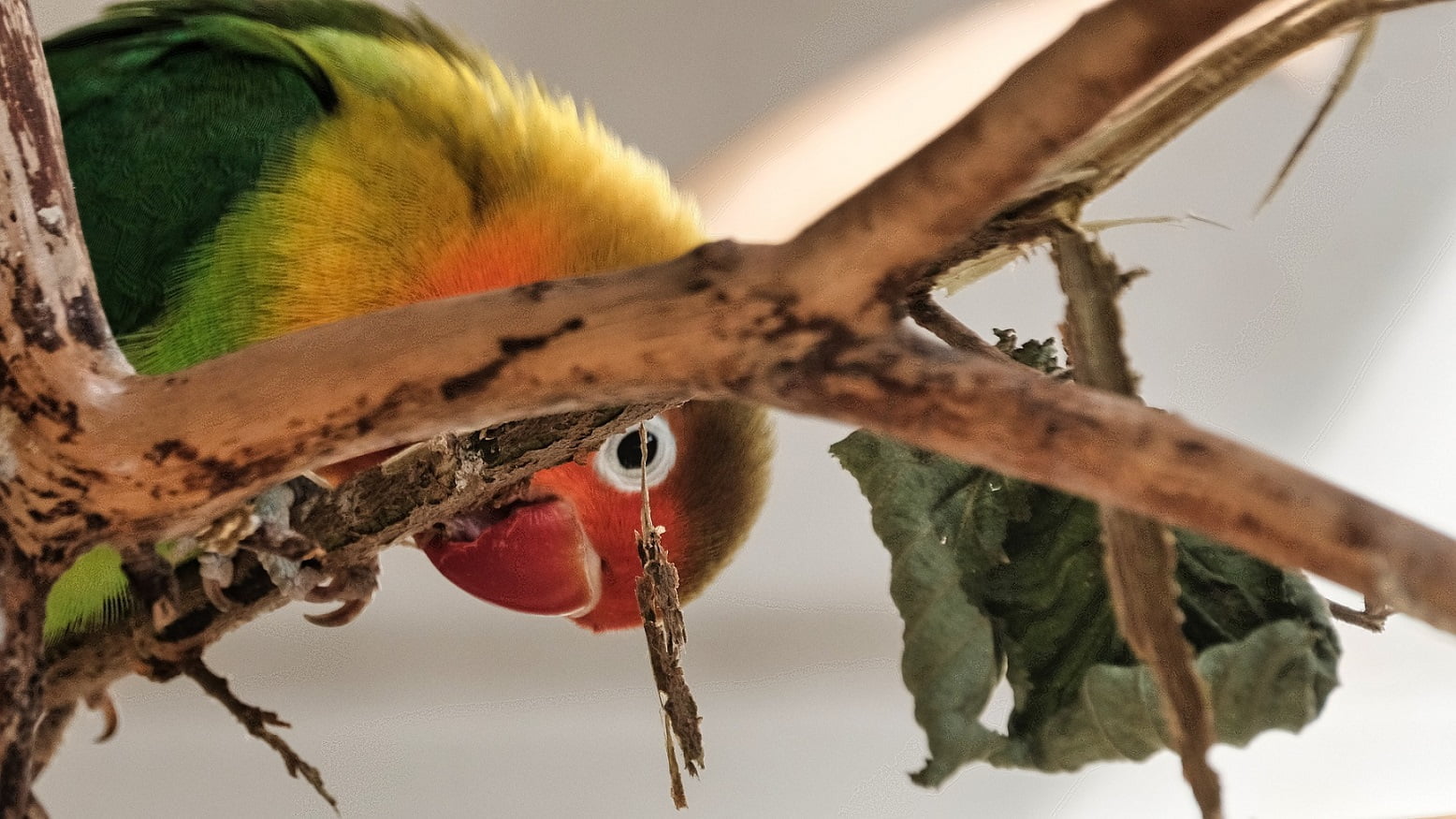Lovebirds prove that great things come in small packages. Their colorful feathers, playful personalities, and loving bonds make them the perfect companions for those who want a little bit of love in their lives.
Love birds are small, colorful birds that are popular pets for many people. These birds are known for their affectionate nature and charming personalities.
However, like any other pet, lovebirds require proper care and maintenance to ensure they are healthy and happy.
In this guide, we will cover all the essential aspects of pet love bird care and maintenance.
Understanding Lovebirds
It’s important to understand what love birds are, their natural habitat, and behavior before getting one as a pet.
This knowledge can help pet owners provide the best care for their feathered friends, ensuring their health and happiness, and enjoying the companionship and love that these charming birds offer.
What is a lovebird?
Lovebirds are small, colorful parrots that are well known for their adorable and affectionate personalities. These birds are beloved by pet owners all around the world for their playful behavior, charming personalities, and strong bond with their mates.
Lovebirds are a group of birds that belong to the genus Agapornis and are native to Africa, specifically the region of Madagascar.
There are nine different species of lovebirds, each with their distinct physical characteristics and personalities.
The Peach-faced Love Bird, Fischer Love bird, and Masked Love Bird are among the most popular love bird species.
The first two birds in particular, are commonly kept as pets due to their playful and affectionate personalities.
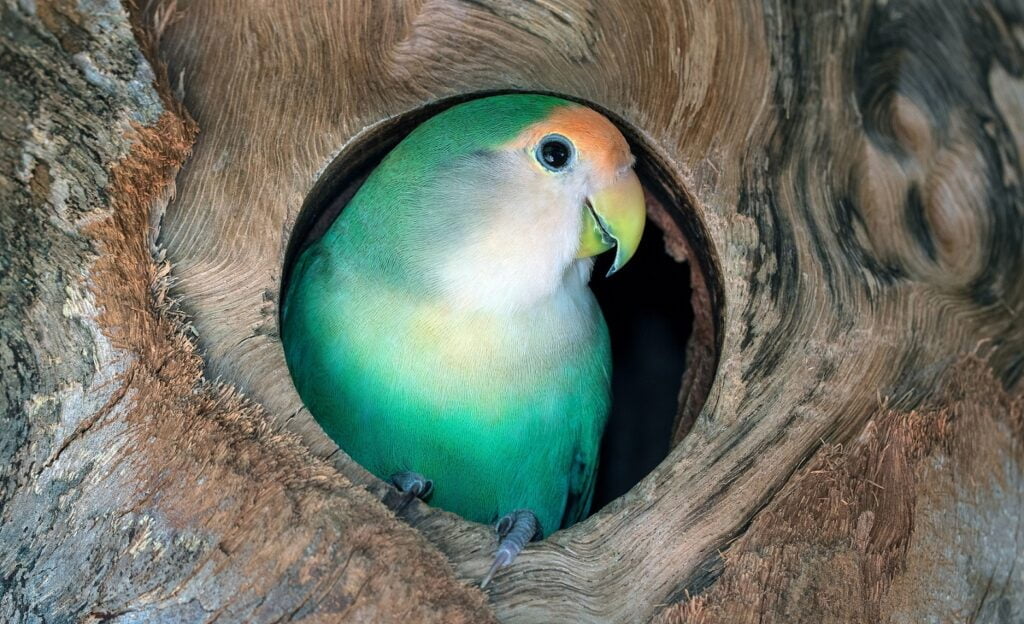
Lovebirds are small in size, measuring only around 5 to 7 inches in length, and they come in a range of colors such as green, blue, yellow, and red.
Their beaks are short and curved, making them excellent at cracking open seeds and nuts, which is their primary source of food.
Lovebirds aren’t just cute little birds – they’re true romantics! These sweethearts form unbreakable bonds with their mates, often snuggling up together, preening each other’s feathers, and serenading each other with songs of love. It’s no wonder why they’re called lovebirds – these little creatures redefine the meaning of true love!
Lovebirds are intelligent birds and are easy to train. They are known to be very social creatures and enjoy interacting with their owners.
They have a very playful nature and love to climb, swing, and explore their surroundings.
This makes them a perfect pet for people who want a bird that is active and engaging.
Preparing for Lovebird Ownership
To ensure that your lovebird stays healthy and happy, you need to create the right living environment for them.
This includes choosing the right cage, accessories, and preparing their living environment.
In this section, we will discuss how to prepare for lovebird ownership and provide some tips for creating the perfect environment for your feathered friend.
Choosing the right cage
The first step in preparing for African love bird ownership is to choose the right cage.
A suitable cage should be spacious enough to accommodate your love bird’s natural behavior and provide room for exercise and play.
Love birds are active birds and need room to fly, climb, and explore. A cage that is too small can lead to boredom and stress, which can cause health problems for your bird.

When choosing a cage for your love bird, look for a cage that is at least 18 inches wide, 18 inches deep, and 24 inches tall. The bars on the cage should be no more than 1/2 inch apart to prevent your love bird from escaping.
The cage should also be made of a sturdy material, such as stainless steel or powder-coated metal. Avoid cages made of plastic or wood, as they can be easily chewed by your bird.
Accessories for the cage
Once you have chosen the right cage for your lovebird, it’s time to add accessories to make their living environment more comfortable and stimulating. Here are some accessories you should consider:
- Perches – Lovebirds love to climb and perch, so make sure to provide them with a variety of perches of different sizes and textures. You can use natural branches or buy perches made of wood, rope, or plastic.
- Toys – Toys are essential for keeping your love bird entertained and stimulated. Provide them with toys that they can chew, swing on, and play with. Avoid toys with small parts that can be swallowed or toys made of toxic materials.
- Food and water dishes – Provide your love bird with food and water dishes that are easy to clean and refill. Stainless steel dishes are a good choice as they are durable and easy to sanitize.
- Cage cover – Love birds need 10-12 hours of sleep each day, so consider using a cage cover to provide a dark and quiet environment for your bird to rest.
Preparing their living environment
Once you have chosen the right cage and accessories for your lovebird, it’s time to prepare their living environment. Here are some tips for creating the perfect environment for your feathered friend:
- Location – Choose a location for the cage that is away from direct sunlight and drafts. Avoid placing the cage near doors or windows as this can cause stress for your bird.
- Temperature – Love birds are sensitive to temperature changes, so make sure to keep their living environment between 65-85 degrees Fahrenheit.
- Cleaning – Love birds can be messy, so it’s important to clean their cage regularly. Replace food and water dishes daily, and clean the cage and accessories with a bird-safe disinfectant weekly.
- Socialization – Love birds are social birds and need daily interaction with their owners. Spend time playing and talking to your love bird each day to keep them happy and well-adjusted. (I have discussed this more in detail below, please check “Love Bird Training and Socialization” section)
Wrapping-up: Preparing for lovebird ownership
Congratulations on your decision to become a proud lovebird owner!
Preparing for love bird ownership is an exciting journey that requires careful consideration and planning.
By taking the time to choose the right cage, accessories, and preparing their living environment, you can create a cozy and welcoming home for your feathered friend.
Lovebird Nutrition and Feeding
Proper nutrition is essential for your lovebird’s overall health and well-being. Their diet should include a balanced mix of seeds, fresh fruits, and vegetables.
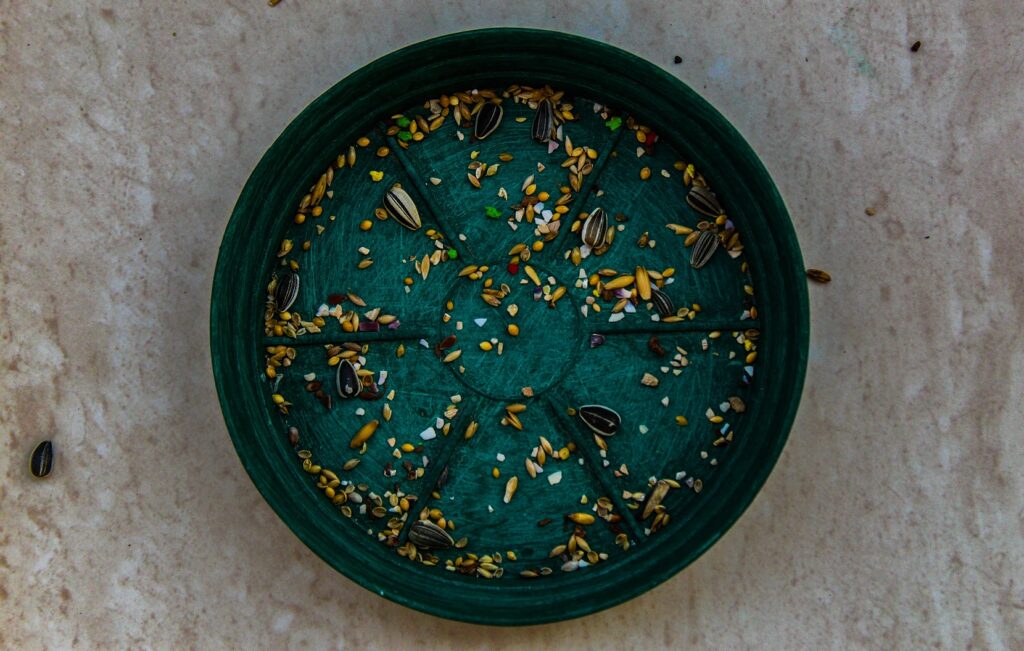
Providing your love bird parrot with a proper diet is essential to their overall health and longevity. In this section, we will discuss the basics of love bird nutrition and feeding.
Seeds
Seeds are an important part of a love bird’s diet. They provide essential nutrients and energy that help your bird stay healthy and active.
However, it is important to note that seeds alone do not provide all of the necessary nutrients that your love bird needs to stay healthy.
A seed-only diet can lead to malnutrition and health problems.
Therefore, it is important to provide a variety of seeds in your love bird’s diet, including sunflower, millet, and safflower seeds.
The table below outlines the nutritional content of common seeds found in love bird seed mixes.
| Seed Type | Nutritional Content | Key Benefits |
|---|---|---|
| Canary Seed | Protein: 16%, Fat: 5%, Fiber: 6% | Low in fat and high in protein, good source of carbohydrates and fiber |
| Millet | Protein: 11%, Fat: 4%, Fiber: 8% | High in carbohydrates and fiber, good source of vitamins and minerals |
| Safflower Seed | Protein: 15%, Fat: 31%, Fiber: 28% | High in healthy fats and protein, helps promote a healthy coat |
| Sunflower Seed | Protein: 12%, Fat: 26%, Fiber: 9% | High in healthy fats, good source of protein and fiber |
| Hemp Seed | Protein: 30%, Fat: 35%, Fiber: 3% | High in healthy fats and protein, good source of vitamins and minerals |
| Niger Seed | Protein: 18%, Fat: 40%, Fiber: 21% | High in healthy fats and protein, good source of fiber and antioxidants |
It’s important to note that while seeds can be a nutritious part of a love bird’s diet, they should be offered in moderation and in combination with a variety of fresh fruits, vegetables, and other healthy foods to ensure a balanced diet.
Fruits and vegetables
Fruits and vegetables are another important part of your lovebird’s diet.
They provide essential vitamins, minerals, and fiber that your bird needs to stay healthy. Fresh fruits and vegetables can be offered to your love bird on a daily basis.
Some good choices include leafy greens like kale and spinach, carrots, peas, apples, and oranges.
Pellets
Pellets are a convenient and easy way to provide your love bird with a well-balanced diet.
Pellets are formulated to provide all of the essential nutrients that your bird needs, including vitamins, minerals, and protein.
Pellets should be offered in addition to seeds, fruits, and vegetables to ensure that your love bird is receiving a well-rounded diet.
Treats
Treats should be offered in moderation, as they are often high in fat and sugar. Some good treat choices include dried fruit, whole-grain bread, and nuts.
Treats should be given sparingly and should not make up a significant portion of your love bird’s diet.
Water
Clean water should be available to your love bird at all times.
Water should be changed daily and the water dish should be cleaned regularly to prevent the growth of bacteria.
Love birds may also enjoy bathing in a shallow dish of water, which can help to keep their feathers clean and healthy.
Feeding schedule
Love birds should be fed twice a day, in the morning and in the evening. Fresh food and water should be provided at each feeding.
Leftover food should be removed from the cage after a few hours to prevent spoilage and the growth of bacteria.
Closing Thoughts: Lovebird nutrition and feeding
Your love bird’s diet is a critical component of their overall health and happiness.
To ensure they receive all the essential nutrients they need, provide a well-balanced mix of seeds, fresh fruits, and vegetables, as well as pellets and treats in moderation.
Keep their water clean and stick to a consistent feeding schedule. By following these steps, you’ll help your love bird thrive and be a happy companion for years to come!
Lovebird Health and Hygiene
Love birds are known for their beautiful plumage and loving personalities, making them a popular choice for pet owners. However, like any other pet, love birds are prone to certain health problems and diseases that can affect their overall well-being.
Therefore, it is crucial for pet owners to ensure that their love birds are healthy and hygienic at all times.
In this section, we will discuss the various health and hygiene aspects that pet owners must keep in mind while taking care of their love birds.
Signs of a healthy love bird
A healthy lovebird will have bright and alert eyes, a shiny and well-groomed coat, and will be active and playful.
On the other hand, if your love bird appears lethargic or shows signs of fatigue, it may indicate a health problem.
Similarly, if your love bird’s plumage is dull or has bald patches, it could be a sign of a feather-plucking disorder.
Common health issues
Love birds are susceptible to several health issues, including respiratory infections, feather-plucking, and digestive problems.
Respiratory infections can cause symptoms such as sneezing, coughing, and difficulty breathing.
Feather-plucking disorder is a behavioral condition where a love bird may excessively preen or pluck its feathers, leading to bald patches and skin irritation.
Digestive problems can result in diarrhea, vomiting, and loss of appetite.
Maintaining cleanliness
Maintaining cleanliness is essential to prevent the spread of germs and bacteria that can cause infections and diseases in love birds.
It is crucial to clean your love bird’s cage regularly, including its perches, toys, and food bowls.
Use a non-toxic disinfectant and make sure to rinse everything thoroughly to avoid any harmful residue.
Also, change the cage liner daily and provide fresh water and food to your love bird every day.
Other hygiene practices
Apart from cleaning the cage, love bird owners must ensure that their pets practice good hygiene habits.
Trim your love bird’s nails and beak regularly to prevent overgrowth and potential injury.
Also, bathe your love bird at least once a week using lukewarm water. Make sure to avoid getting water in the bird’s nostrils or eyes.
Conclusion: Lovebird health and hygiene
In conclusion, love birds are lovable and social creatures that require proper care and attention from their owners.
To ensure that your love bird remains healthy and happy, it is crucial to pay attention to its health and hygiene needs.
Keep a watchful eye for any signs of illness or distress, maintain cleanliness in their cage, and practice good hygiene habits.
By doing so, you can enjoy a long and healthy relationship with your feathered friend.
Lovebird Training and Socialization
Lovebirds are intelligent birds that can be trained to perform various tricks and behaviors.
Training your love bird will not only help them develop new skills but also improve their overall mental and physical health.
Socializing with other birds is also important to provide your love bird with a sense of community and reduce boredom.
In this section, we’ll explore the world of love bird training and socialization, offering tips and tricks to help you develop your feathered friend’s skills and keep them stimulated and engaged.
Training your lovebird
Lovebirds are intelligent birds that can be trained to perform various tricks and behaviors.
Training your love bird can help them stay mentally stimulated and prevent boredom.
Here are some tips for training your love bird:
- Start with simple tricks – Begin with simple tricks such as stepping onto your hand or perch. Reward your love bird with treats or verbal praise to reinforce positive behavior.
- Use positive reinforcement – Positive reinforcement is key to training your love bird. Reward your love bird for performing desired behaviors and ignore or redirect unwanted behaviors.
- Keep training sessions short – Love birds have short attention spans, so it’s important to keep training sessions short and frequent. Aim for 10-15 minute training sessions once or twice a day.
- Be patient – Training your love bird takes time and patience. Don’t get discouraged if your love bird doesn’t pick up on a trick right away. Keep practicing and rewarding positive behavior.
- Use a clicker – Clicker training is a popular method for training birds. The clicker is used as a marker for desired behavior and is followed by a treat or reward.
Some popular tricks that love birds can be trained to perform include waving, turning around, and playing dead.
However, it’s important to keep in mind that not all love birds will enjoy performing tricks or may take longer to learn.
Socializing your lovebird
Socializing your lovebird is important for their overall well-being. In the wild, love birds live in flocks and socialize with other birds.
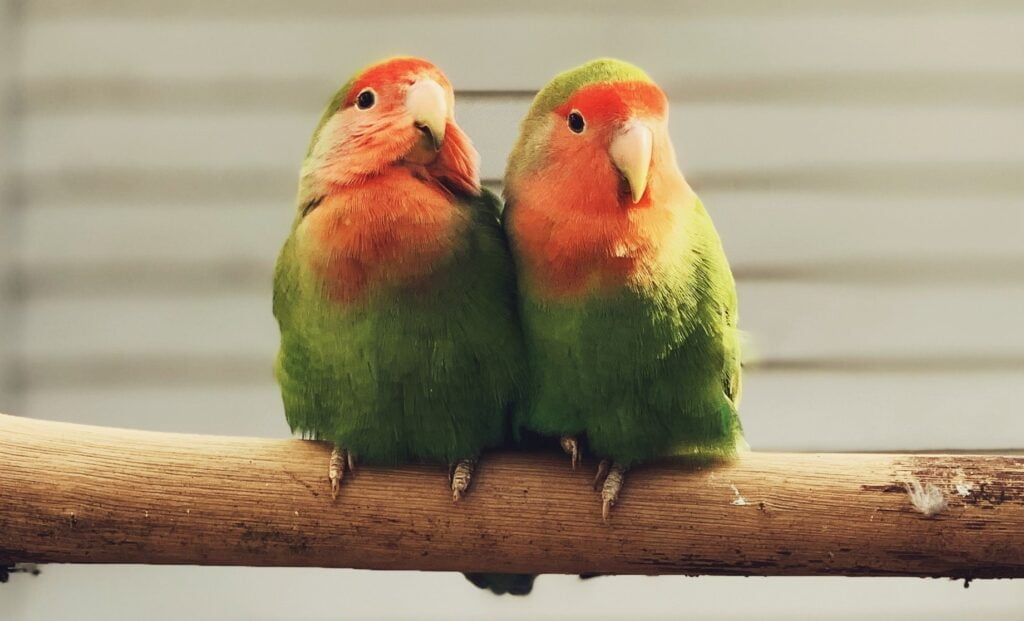
In captivity, it’s important to provide your love bird with opportunities to socialize with other birds or interact with their owners.
Here are some tips for socializing your lovebird:
- Introduce your love bird to other birds – Introduce your love bird to other birds of similar size and temperament. Always supervise interactions to ensure that there is no aggression or bullying.
- Provide toys and perches – Providing toys and perches can help your love bird stay mentally stimulated and reduce boredom. Rotate toys and perches regularly to keep your love bird interested.
- Spend time with your love bird – Spending time with your love bird can help build trust and strengthen your bond. Talk to your love bird, offer treats, and allow them to explore their surroundings under your supervision.
- Take your love bird outside – Taking your love bird outside in a secure carrier or harness can provide them with new sights, sounds, and smells. This can be a great way to reduce boredom and provide mental stimulation.
Final Word: Love Bird Training and Socialization
With the right training and socialization, your love bird can be a happy and healthy pet that brings you joy and companionship.
By following the tips and tricks we’ve outlined in this article, you can help your bird develop new skills, build trust with you, and stay mentally stimulated.
Whether you’re teaching them new tricks or introducing them to other birds, investing time and effort in your love bird’s training and socialization will pay off in the long run.
So why not start today and see the amazing transformation in your feathered friend?
Lovebird Breeding and Reproduction
Breeding love birds requires careful planning and consideration.
You should ensure that you have the necessary knowledge and resources before attempting to breed lovebirds.
Providing proper care for young love birds is essential to ensure their health and survival.
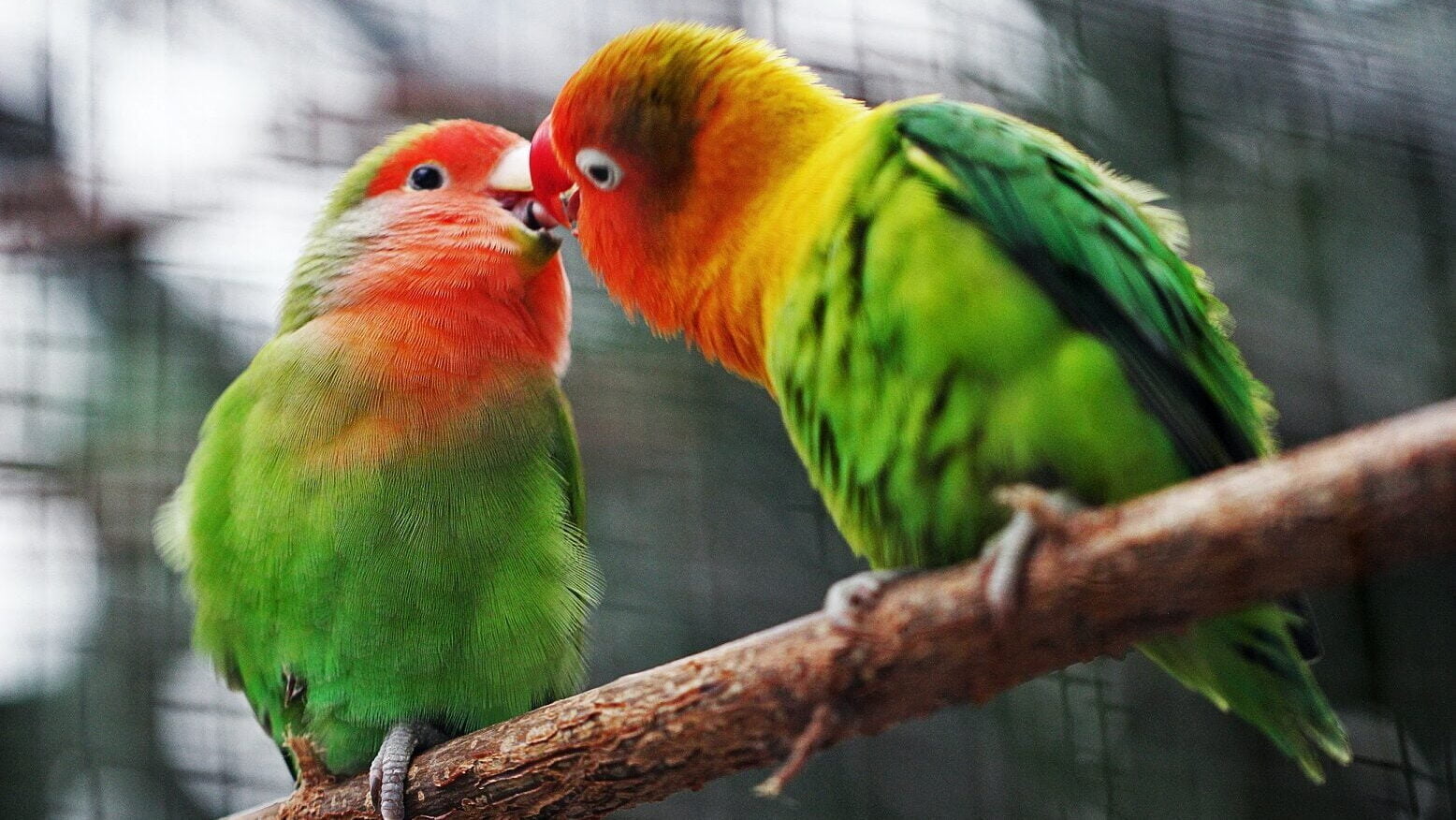
In this section, we’ll explore the ins and outs of breeding and reproduction in love birds, including their reproductive habits, the requirements for breeding, and essential tips for raising healthy love bird chicks.
Reproductive Habits of Love Birds
Love birds reach sexual maturity at around 10 months of age.
In the wild, they typically breed during the rainy season when food is abundant.
However, in captivity, love birds can breed year-round if the conditions are favorable.
Love birds are monogamous and will form strong bonds with their partners. They will also display courtship behavior such as singing and feeding each other to strengthen their bond.
Breeding Requirements
Before attempting to breed love birds, it is important to ensure that you have the necessary resources and knowledge.
Breeding love birds can be challenging, and it requires a significant investment of time and money. Here are some of the requirements you will need to consider:
- Cage – Love birds need a spacious cage that is at least 24 inches long, 18 inches wide, and 18 inches tall. The cage should also have plenty of perches and toys to keep the birds entertained.
- Nest Box – Love birds will need a nest box to breed. The nest box should be made of wood and be at least 12 inches long, 8 inches wide, and 8 inches tall. It should also have a small entrance hole, about 2 inches in diameter, to allow the birds to enter and exit.
- Food and Water – Love birds need a balanced diet that includes a mix of seeds, fruits, and vegetables. They also need fresh water available at all times.
- Temperature and Lighting – Love birds require a warm, humid environment with a temperature range of 70-80°F. They also need access to natural light, as well as a UVB lamp to provide them with essential vitamin D.
Breeding Process
Once you have all the necessary resources in place, you can begin the breeding process.
Here are the steps you should follow:
- Introduce the Birds – Place the male and female love bird in the same cage and allow them to bond. They may take several weeks to establish a strong bond.
- Provide a Nest Box – After the birds have bonded, provide them with a nest box. The nest box should be large enough to accommodate the birds and should have a small entrance hole. It’s important to note that lovebirds often prefer to design their own nest, so it’s best to provide nesting material separately for them to use as they see fit.
- Provide Nesting Material – Provide the lovebirds with nesting material such as shredded paper, coconut fiber, or dry grass. Place the nesting material in a separate container or basket within the cage so that the birds can use it to design their own nest.
- Monitor the Birds – Keep a close eye on the birds during the breeding process. Make sure they have plenty of food and water and that the nest box is clean. Check the nesting material regularly to ensure that it is fresh and dry.
- Incubation Period – Lovebirds typically lay 4-6 eggs, which will hatch after about 21 days. During this time, the female will spend most of her time in the nest box, incubating the eggs.
- Raising the Chicks – Once the chicks hatch, they will need to be fed every 2-3 hours. You can feed them a mixture of baby bird food and water using a syringe or pipette. It is also important to keep the nest box clean and free of waste. As the chicks grow, the lovebirds will continue to add more nesting material to the box to provide a comfortable and safe environment for them.
Tips for Raising Healthy Lovebird Chicks
Raising lovebird chicks can be challenging, but with the right care, you can ensure their health and survival.
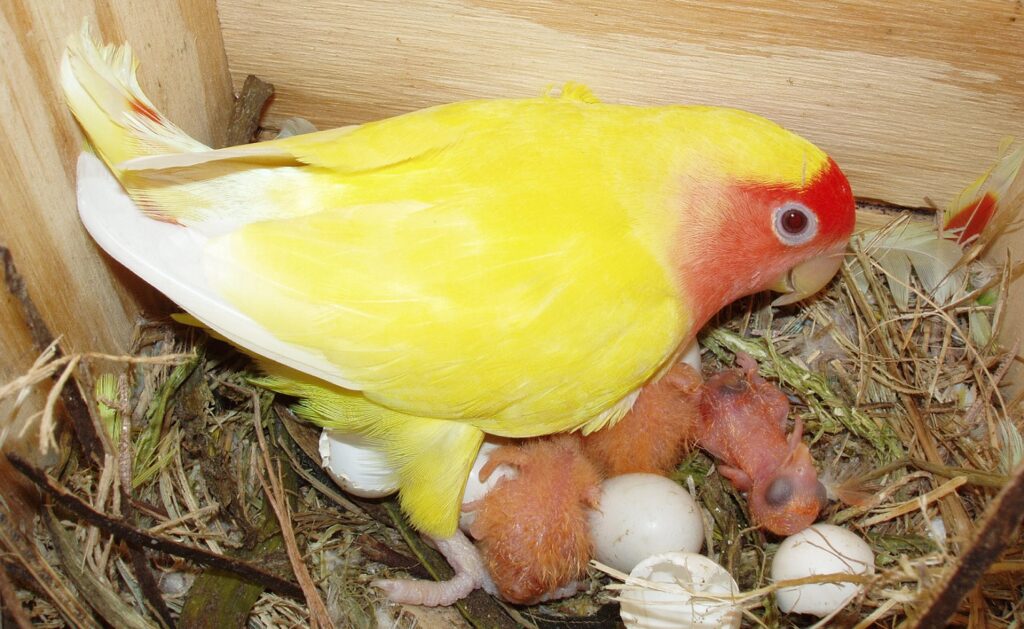
Here are some tips for raising healthy lovebird chicks while minimizing disturbances to their nest:
- Keep the Nest Box Clean – Lovebird chicks are vulnerable to infection, so it is essential to keep their nest box clean and free of waste. Try to clean the nest box when the parents are out of the cage or at night when they are sleeping.
- Monitor the Chicks – Keep a close eye on the chicks to make sure they are growing and developing properly. Check their weight regularly and observe their behavior to ensure they are active and alert. Avoid touching the chicks or nest box unnecessarily, as this may cause the parents to become agitated.
- Provide Adequate Nutrition – Lovebird chicks require a high-protein diet to support their growth and development. You can feed them a mix of baby bird food and water using a syringe or pipette. You can also offer them small pieces of fruits and vegetables as they get older. Try to feed the chicks when the parents are out of the cage or distracted with other activities.
- Socialization – Lovebird chicks should be handled regularly to help them become socialized and comfortable around people. However, it is important to handle them gently and avoid overhandling, which can cause stress. Start handling the chicks gradually, for short periods of time, and gradually increase the duration as they get older.
- Gradual Weaning – As the chicks get older, you can gradually introduce them to solid food and decrease their dependence on hand-feeding. This process should be done slowly and gradually over several weeks to avoid stress and digestive issues. Try to introduce solid food when the parents are out of the cage or distracted with other activities.
Summary: Breeding and Reproduction
Breeding lovebirds can be a rewarding experience for pet owners, but it requires careful planning and consideration.
Before attempting to breed love birds, it is important to ensure that you have the necessary resources and knowledge.
Providing proper care for young love birds is essential to ensure their health and survival.
By following the guidelines outlined in this section, you can help ensure the success of your breeding efforts and raise healthy love bird chicks.
Common Questions and Answers about Lovebirds
It’s important to understand lovebirds needs and behavior to ensure they thrive in your care.
In this section, we’ll answer some common questions about love birds to help you give them the best possible care.
Q: How do you tell the gender of a love bird?
Below are some information that can help you identify the gender of a lovebird through visual cues:
1. Dimorphic Species: Three species of lovebirds, namely the Madagascar, red-faced, and Abyssinian lovebirds, are considered dimorphic. That means the color of their feathers alone can tell you whether they are male or female. In these species, males have more vibrant colors, while females are usually more muted. For example, male Madagascar lovebirds have bright green feathers on their backs, while females have a duller green color. Similarly, male red-faced lovebirds have a bright red patch on their face, while females have a smaller, less intense patch.
2. Beak Size and Shape – The beak is another good visual cue to determine the gender of lovebirds. Female lovebirds generally have thicker and broader beaks than males, although this may not be noticeable in all cases. You can compare the size and shape of the beaks of your lovebirds side by side to see if there is a difference.
3. Ring Size – Female lovebirds generally have larger rings around their eyes than males. However, this is not always a reliable indicator since every lovebird is different. It can be a good starting point, but it should be combined with other methods for more accurate results.
4. Head Shape – Female lovebirds have a more rounded and proportionate head shape in comparison to their bodies, while males have blockier and less curved heads than females. This is not always a reliable indicator, especially if your lovebirds are still young and have not reached sexual maturity.
5. Size – In most cases, male lovebirds appear to be larger than their female counterparts. However, this is not always a reliable indicator since the size difference can be minimal and can also be influenced by their stance.
It is essential to note that these visual cues are not always foolproof methods for determining the gender of lovebirds. Each bird is unique, and some may not exhibit the characteristics that are typical of their gender. If you want to be 99% sure about your lovebird’s gender, it’s best to consult your local avian veterinarian for a DNA test, also called as DNA sexing.
Q: What is DNA sexing?
DNA sexing is the most reliable and accurate method for determining the gender of a lovebird. This method involves taking a small blood sample or plucking a few feathers from the bird and sending it to a laboratory for analysis.
The laboratory then analyzes the DNA in the sample and determines the bird’s gender. DNA sexing is highly accurate, with a 99% accuracy rate, and is considered the gold standard for determining the gender of a lovebird.
Q: Do love birds make good pets?
Yes, love birds can make great pets. They are social creatures that thrive on interaction and attention from their owners. However, they do require daily attention and care, including regular exercise and a healthy diet.
Q: How long do love birds live?
The average lifespan of a love bird is around 10 to 15 years, but with proper care, some love birds can live up to 20 years or more.
Q: Can love birds live alone?
Love birds are social birds and thrive on companionship, so it is not recommended to keep them alone for extended periods of time. It is best to keep them in pairs or in a group of birds.
Q: What should I feed my love birds?
Love birds should be fed a diet of high-quality pellets, fresh fruits and vegetables, and occasional treats like seeds or nuts. It is important to avoid feeding them foods that are high in fat or sugar, as these can lead to health problems.
Q: How do love birds mate?
Love birds mate by preening each other, sharing food, and engaging in courtship behaviors like wing flapping and chirping. Once they have chosen a mate, they will typically stay together for life.
Q: Can love birds learn to talk?
While love birds are not known for their ability to talk like some other parrot species, they can learn to mimic sounds and words with proper training and socialization. However, not all love birds will have this ability, and it may vary from bird to bird.
Q: How do you train love birds?
Love birds can be trained using positive reinforcement techniques, such as offering treats and praise for desired behaviors. Consistency and patience are key when training love birds.
Q: Can love birds be kept in cages?
Yes, love birds can be kept in cages as long as the cage is large enough to accommodate their needs. The cage should be at least 18 inches wide, 18 inches deep, and 24 inches tall for a single love bird, with additional space for each additional bird.
Q: Do love birds need toys?
Yes, love birds need toys to keep them mentally stimulated and physically active. Toys can also help prevent behavioral problems, such as feather plucking.
Q: What is the best type of cage for love birds?
The best type of cage for love birds is a large, rectangular cage with horizontal bars. The bars should be spaced no more than 1/2 inch apart to prevent escape, and the cage should have multiple perches and toys. The larger the cage the better.
Q: Do love birds need a special type of nesting box?
Yes, love birds need a nesting box that is large enough to accommodate both birds and has a small entrance hole to provide privacy. The box should be placed high in the cage and filled with nesting materials, such as shredded paper or coconut fiber.
Q: Can love birds be trained to do tricks?
Yes, love birds can be trained to do simple tricks such as stepping onto a finger or spinning around. However, they may not be as trainable as some other parrot species.
Q: How often should I clean my love bird’s cage?
Love bird cages should be cleaned at least once a week, with daily spot cleaning as needed. All food and water dishes should be cleaned daily.
Q: What are some common health problems in love birds?
Common health problems in love birds include respiratory infections, feather plucking, and fatty liver disease. Regular veterinary check-ups can help prevent and treat these problems.
Q: Are love birds noisy?
Love birds can be noisy, especially during breeding season or if they feel threatened. However, they are generally quieter than some other parrot species, such as macaws or cockatoos.
Q: Can I feed chicken feed to love birds?
Love birds should not be fed chicken feed as their primary diet. While chicken feed may contain some nutrients that are suitable for love birds, it is not a complete and balanced diet for them. Love birds require a diet that is specifically formulated for their nutritional needs, which includes a variety of seeds, pellets, fruits, and vegetables.
Chicken feed is formulated for the nutritional needs of chickens, which are very different from those of love birds. Chicken feed often contains high levels of protein, which can be harmful to love birds in excess. Additionally, chicken feed may contain antibiotics or other additives that are not suitable for love birds.
It’s essential to feed love birds a diet that meets their specific nutritional needs to ensure their long-term health and well-being.
Q: How much is a love bird?
The cost of a lovebird can vary depending on the species, age, and location. On average, a single lovebird can cost between $50 to $200. However, if you want to buy a pair of lovebirds, the cost can range from $150 to $500, depending on the same factors. Keep in mind that there are additional expenses to consider, such as a cage, food, toys, and veterinary care.
Q: How to tell your bird you love them?
Although love birds may not understand words, they can still sense your love and affection through your actions and behavior towards them. Here are some ways to express your love to your bird:
1. Spend time with them – Birds thrive on attention and love spending time with their human companions. Set aside some time each day to interact with your bird, talk to them, and engage in activities that they enjoy.
2. Provide a healthy environment – Ensure that your love bird has a clean and safe living space with plenty of toys and perches. Providing a healthy diet and fresh water is also crucial to their overall well-being.
3. Offer treats – Giving your bird friend occasional treats can be a great way to show them some extra love. Just make sure to only offer healthy treats in moderation.
4. Show physical affection – Lovebirds enjoy physical contact, such as head scratches or cuddling. However, it’s important to make sure your bird is comfortable with this kind of contact and not feeling stressed or frightened.
5. Use positive reinforcement – Positive reinforcement training can be an excellent way to bond with your lovebird and reinforce good behavior. Use treats or praise to reward your bird for good behavior and avoid punishment or negative reinforcement.
Q: How to make a lovebird cage?
Making a lovebird cage can be a fun and rewarding DIY project. Here are some general steps to follow:
1. Choose the right materials – You will need materials such as wire mesh, metal sheets, screws, nails, and a wooden frame. Make sure the materials are sturdy and safe for your bird.
2. Determine the size of the cage – The cage should be big enough for your lovebird to stretch its wings and fly. A minimum size for a single lovebird is 18 x 18 x 24 inches, but bigger is always better.
3. Design the cage – Sketch out your cage design, including the dimensions, door placement, and any additional features like perches, swings, or feeders.
4. Construct the frame – Start by building the wooden frame of the cage, using nails and screws to secure the pieces together.
5. Install the wire mesh – Cut the wire mesh to size and attach it to the frame with screws and washers.
6. Add the metal sheeting – Cut the metal sheeting for the base of the cage and attach it to the frame with screws.
7. Install the doors – Cut and attach the doors to the frame with hinges and latches.
8. Add the finishing touches – Install perches, swings, feeders, and any other features you want to include.
9. Test the cage – Make sure the cage is secure and safe for your lovebird by checking for any loose screws or sharp edges.
Overall, building a lovebird cage requires some basic DIY skills and attention to detail. If you’re not confident in your ability to build a safe and sturdy cage, it’s best to purchase one from a reputable pet store or online retailer.
Q: Why does my love bird follow me around?
Lovebirds are social birds and enjoy spending time with their owners. If your lovebird is following you around, it is likely a sign that they want to be near you and feel comfortable in your presence.
They may also be seeking attention, food, or playtime. It’s important to ensure that your lovebird has plenty of mental and physical stimulation to prevent boredom and promote overall health and happiness.
Q: What is a love bird cereal?
Lovebird cereal is a breakfast cereal product that is grain-free, refined sugar-free, AIP (Autoimmune Protocol) friendly, and glyphosate-free. It is made from nutrient-rich superfood ingredients, with a focus on gut health and supporting the immune system.
The creators of Lovebird cereal, Parker and Yukiko, were inspired to make a healthier breakfast option after the birth of their daughter. They wanted to clean up junk food by using food from the earth, with a light natural sweetener.
Their mission is to provide a healthy breakfast option that is made with real food and to give back to the community by donating 20% of profits to fight childhood cancer. The Lovebird cereal packaging features the phrase “Rise and Fly,” with a message of encouragement to follow your heart and keep moving forward.
Note: Lovebird cereal is a food product designed for human consumption. It is not formulated specifically for birds or other animals and may not meet their nutritional needs.
Q: What do love bird sounds make?
Lovebirds are known for their chattering, vocalizations, and playful sounds. They have a wide range of sounds that they use to communicate with each other, such as chirps, tweets, whistles, and squawks. They can also make loud, piercing calls when they feel threatened or alarmed. Some lovebirds are known to mimic human speech and other sounds that they hear in their environment. Each lovebird has its unique vocalization, and owners can become familiar with their birds’ sounds and use them as a way of communicating with their pets.
By understanding lovebirds more, you can create a happy and healthy environment for them to thrive in.
Whether you’re a seasoned bird owner or a first-time bird parent, we hope above has answered some of your questions about love birds and helped you provide the best possible care for your feathered friend.
Ensuring the Well-being of Your Beloved Love Birds
Lovebirds are wonderful pets that require proper care and maintenance to ensure they are healthy and happy.
By understanding their behavior and needs, you can provide them with a suitable living environment and ensure they receive proper nutrition and care.
We hope that this guide has provided you with the information you need to care for your love bird properly. Remember, owning a lovebird is a responsibility that requires time, effort, and commitment.
Also Read: The Dog Food Dilemma: 25 Common Questions Answered
Well, what do you think about the article?
Did you enjoy reading “The Complete Guide to Love Bird Care and Maintenance“? If so, please comment down below. We would love to hear your thoughts about this comprehensive guide.
To see more content like this check the guides section of Money For My Beer.

Chief Editor and Website Owner.
Hey, I’m Ryan, a software guy and the owner of Money For My Beer. I’m the one making sure all our posts on the site are awesome.
I usually handle tech stuff that might not be super interesting to everyone, like programming enterprise software, apps, games, and websites. Cool stuff, right? I also help clients with SEO and sometimes create games.

